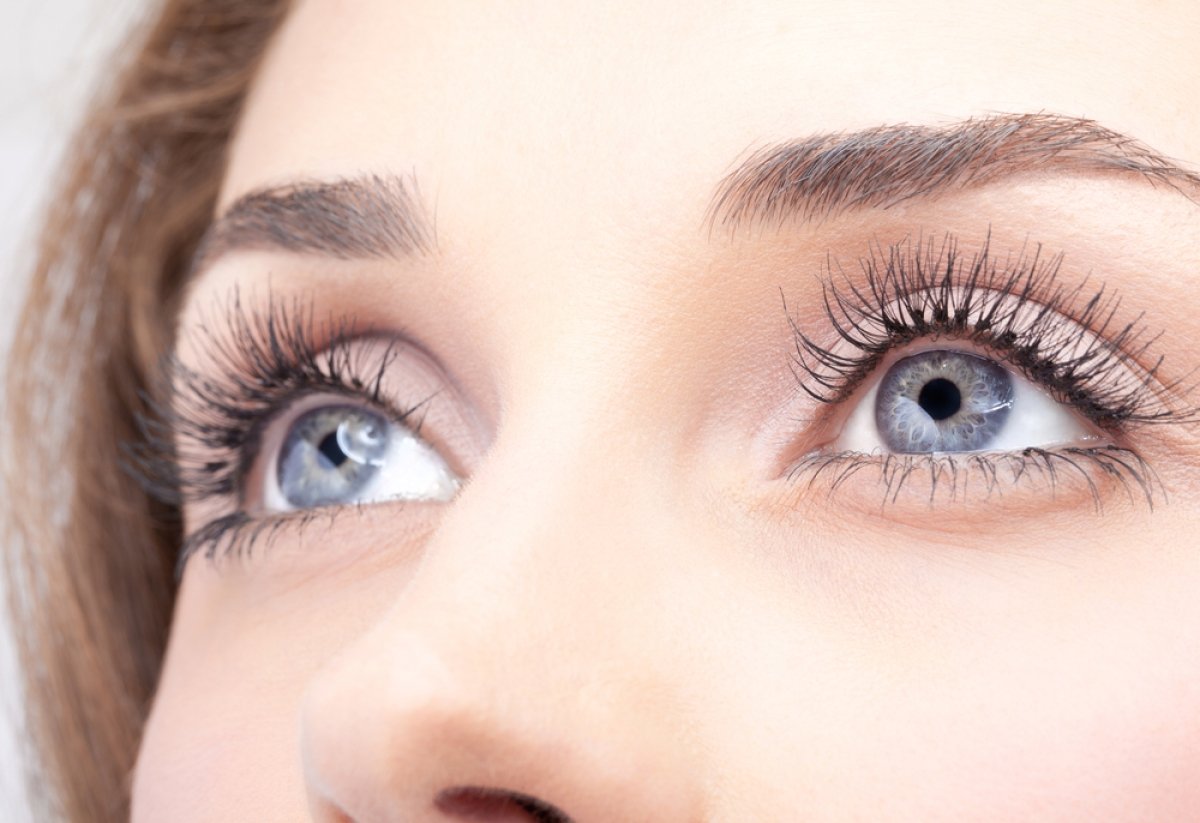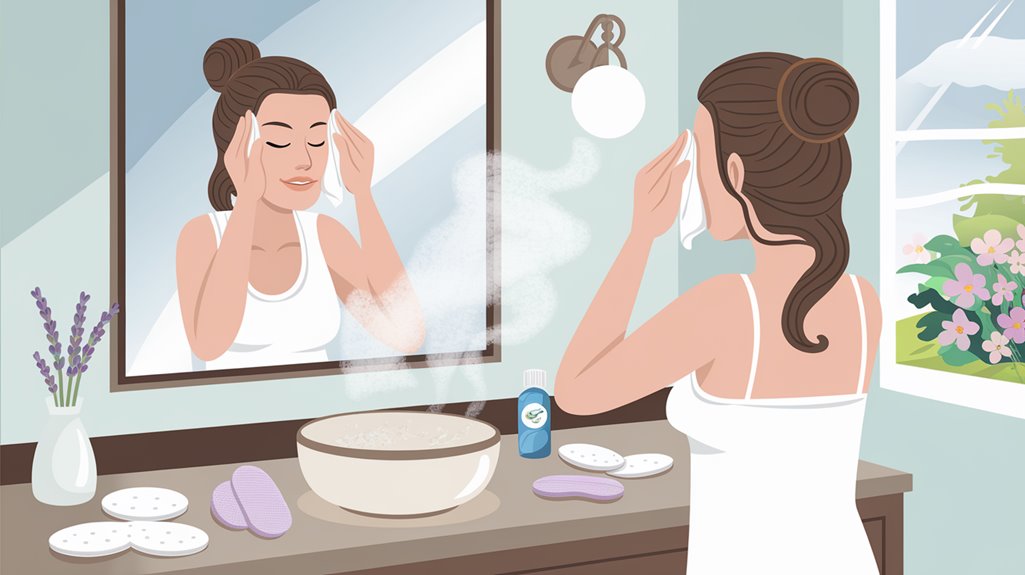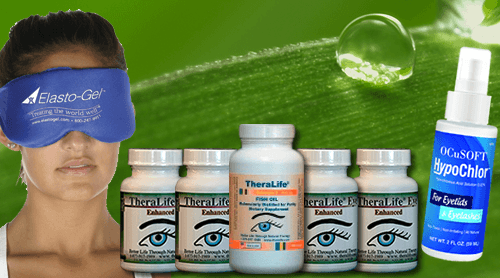To effectively manage blepharitis at home, consider integrating Theralife's products into your routine for enhanced eye care. Begin with a warm compress to soothe your eyelids, and follow up with Theralife's gentle lid scrub designed for sensitive areas, ensuring regular eyelid hygiene by cleaning twice daily. Theralife's supplements, rich in omega-3 fatty acids, can further help reduce inflammation and improve overall eye health. Explore Theralife's comprehensive range of products and resources for in-depth insights into maintaining clear and comfortable eyes.
Key Takeaways
- Apply warm compresses on eyelids twice daily to loosen debris and reduce inflammation.
- Perform gentle lid scrubs with a sensitive eyelid cleanser to remove oils and crusts.
- Maintain eyelid hygiene by cleaning eyelid margins with diluted baby shampoo twice daily.
- Incorporate omega-3 fatty acids and vitamins A, C, and E into the diet for eye health.
- Minimize exposure to allergens and maintain room humidity to prevent eye irritation.
Understanding Blepharitis and Its Causes
Blepharitis, a common eyelid inflammation, arises primarily from dysfunction of the oil glands at the base of the eyelashes. This dysfunction can be attributed to several causes of blepharitis, including bacterial infections, dandruff of the scalp or eyebrows, and allergies. These factors contribute to the blockage of the Meibomian glands, leading to inflammation. You might experience classic symptoms of blepharitis, such as red, swollen eyelids, a gritty sensation, and crusting at the base of the eyelashes. Itching and burning are also prevalent, often exacerbating discomfort. In chronic cases, symptoms of blepharitis can include blurred vision and eyelash loss. Early identification of these causes and symptoms is essential for effective management and treatment of this persistent condition. To prevent symptom recurrence, regular eyelid hygiene is crucial, as it helps minimize the chance of blepharitis reappearing.
Preparing a Warm Compress
To effectively prepare a warm compress for blepharitis, start by selecting a clean, soft cloth or a commercially available eye pad. Heat the material using warm water or a microwave-safe method to achieve a temperature between 104°F and 113°F, as studies show this range is ideal for improving eyelid function. Apply the compress gently to your closed eyelids for 5-10 minutes to alleviate symptoms. For optimal results, consistent application of the warm compress throughout the day is recommended, as it enhances the effectiveness of the treatment.
Choosing the Right Material
When preparing a warm compress, selecting the right material is essential to guarantee effectiveness in treating blepharitis. Opt for fabric types like cotton or microfiber, which are both absorbent and soft, providing gentle contact with the sensitive eyelid area. These materials are preferred due to their breathability, allowing the compress to maintain a consistent temperature while avoiding moisture buildup. Material safety is paramount, especially for daily use near the eyes. Verify the fabric is free from dyes and chemicals that could irritate your skin. Always use clean, freshly laundered materials to prevent introducing bacteria to the eye area. It is important to remember that blocked glands and thick oil secretion are indicative of posterior blepharitis, which can be alleviated with the proper use of warm compresses.
Heating and Application Method
While preparing a warm compress for blepharitis treatment, make certain the water temperature is carefully controlled to avoid burns or discomfort.
Utilize precise heating methods by warming water to approximately 104°F (40°C) for ideal effectiveness. Soak a clean cloth in the warm water, ensuring it's thoroughly saturated. After wringing out excess water, apply the compress over your closed eyelids for 5 to 10 minutes.
This application technique helps loosen any crust or debris on the eyelid margin, promoting relief. Reheat the cloth as needed to maintain consistent warmth throughout the treatment.
Repeat this process two to three times daily, as regular application can greatly alleviate symptoms. Always confirm the compress is comfortably warm, not hot, before use.
For best results, complement warm compress use with a dedicated eyelid cleanser, as specialized eyelid cleansers are more effective against bacteria than traditional methods.
Performing Gentle Lid Scrubs
To effectively perform gentle lid scrubs for blepharitis, start by choosing a cleanser that's specifically formulated for sensitive eyelids, such as a diluted baby shampoo or a commercially available eyelid scrub. Apply the cleanser to a clean cotton pad or swab, and gently scrub the eyelid margins using small, circular motions to remove debris and excess oil. For best results, perform this procedure twice daily, as consistent application has been shown to improve symptoms of blepharitis. Incorporating warm compresses can further enhance the effectiveness of this routine by helping to unclog and release oils from the meibomian glands.
Choosing the Right Cleanser
Selecting an appropriate cleanser is crucial for performing effective and gentle lid scrubs to manage blepharitis. Various cleanser types are available, each with unique properties suitable for different needs.
Opt for cleansers with natural ingredients like tea tree oil, which has antimicrobial properties and can alleviate symptoms. Consider hypoallergenic options to minimize irritation. Micellar water is another gentle choice, effectively removing debris without harsh chemicals.
Avoid products with fragrances and alcohol, as they may exacerbate irritation. Evaluate the ingredient list for sulfates or parabens, which might harm sensitive eyelid skin.
Evidence suggests that lid scrubs with the right cleanser can reduce inflammation and bacterial load, thereby improving comfort. Always consult with an eye care professional to verify the cleanser suits your condition.
For those looking for a natural and effective option, consider using an eyelid and eyelash cleanser that contains pure hypochlorous acid, as it helps defend against pathogens without harsh additives.
Proper Scrubbing Technique
Performing gentle lid scrubs is essential for managing blepharitis and ensuring ideal eye health.
Effective lid hygiene involves using precise scrub techniques to remove debris and bacteria from the eyelid margins. Start by washing your hands thoroughly. Dampen a clean, lint-free pad with warm water or a recommended cleanser.
Gently close your eyes and apply the pad to your eyelids, exerting light pressure. Use a horizontal motion to sweep the pad along the lash line, ensuring you cover both upper and lower lids. This action helps dislodge accumulated oils and dead skin, reducing inflammation and irritation. Consistent lid hygiene can help prevent bacterial growth that exacerbates blepharitis symptoms.
Avoid excessive force to prevent damage. Consistent use of proper scrubbing techniques can greatly improve symptoms and promote clearer, more comfortable eyes.
Frequency of Application
Maintaining ideal eye health involves not only mastering the proper scrubbing technique but also understanding how often to apply it. Consistent treatment is essential for managing blepharitis effectively. Typically, the recommended application frequency is once or twice daily. Adjust frequency based on symptom severity and personal response. Regular lid scrubs help remove debris and prevent bacterial buildup, ensuring treatment consistency. Daily eyelid hygiene practices, such as using hypoallergenic cleansers, play a crucial role in reducing irritation and maintaining ocular health.
| Frequency | Suitable For | Benefits |
|---|---|---|
| Once daily | Mild symptoms | Reduces irritation |
| Twice daily | Moderate symptoms | Improves comfort and hygiene |
| Variable | Severe symptoms | Tailored to individual needs |
| Incremental | Initial treatment | Observes response and adjust |
| Maintenance | Long-term care | Sustains eye health |
Maintaining Proper Eyelid Hygiene
A crucial step in managing blepharitis is making certain your eyelids remain clean and free from debris. Effective eyelid care involves establishing consistent hygiene routines to prevent flare-ups.
Start by using a gentle cleanser or baby shampoo diluted with warm water. Apply the solution to a clean cloth or cotton swab, then gently clean the eyelid margins, focusing on the lash line to remove oils and crusts. Perform this routine twice daily, morning and night, to maintain peak hygiene.
Research supports the efficacy of regular eyelid cleaning in reducing symptoms. Avoid harsh soaps that can irritate sensitive skin. Make sure your hands are clean before touching your eyes to minimize bacterial transfer. Consistent care can greatly alleviate discomfort and improve eye health.
To further enhance your routine, consider using Avenova eyelid cleanser after warm compresses to effectively clean and maintain eyelid health.
Exploring Dietary Changes for Eye Health
While managing blepharitis, consider the role of nutrition in supporting eye health. Nutrient sources rich in vitamins A, C, and E, along with zinc, are pivotal. These nutrients can help reduce inflammation and maintain the conjunctiva's integrity. Hydration importance can't be overstated; sufficient fluid intake supports tear production, reducing eye irritation. Maintaining bedroom humidity at 40% or higher aids tear production, with the use of a hygrometer to monitor indoor humidity levels.
| Nutrient Source | Benefits for Eyes | Examples |
|---|---|---|
| Vitamin A | Maintains vision | Carrots, spinach |
| Vitamin C | Antioxidant | Oranges, strawberries |
| Vitamin E | Protects cells | Almonds, sunflower seeds |
| Zinc | Supports retina | Oysters, beef |
| Water | Hydration | Essential for tear production |
Integrating these nutrients and maintaining hydration can lead to clearer, more comfortable eyes.
Incorporating Omega-3 Fatty Acids
Incorporating omega-3 fatty acids into your diet could greatly benefit those managing blepharitis. These essential nutrients help reduce inflammation, a key factor in blepharitis. You can find omega-3 sources in foods like fatty fish, such as salmon and mackerel, as well as flaxseeds and walnuts.
These foods provide eicosapentaenoic acid (EPA) and docosahexaenoic acid (DHA), which are vital for eye health.
If dietary intake is insufficient, consider supplement options. Fish oil capsules are widely used and effective, offering a concentrated dose of omega-3s.
Look for supplements with high EPA and DHA content for maximum benefit. Verify any supplement is third-party tested for purity and potency to support eye comfort effectively.
Managing Environmental Triggers
Environmental factors can greatly impact blepharitis symptoms, so managing these triggers is essential for effective treatment.
First, minimize exposure to environmental allergens such as pollen, dust, and pet dander. Use air purifiers with HEPA filters to reduce allergen presence indoors.
Maintain ideal humidity levels between 30% and 50% using a humidifier to prevent dry air from exacerbating symptoms. Avoid smoke-filled environments as smoke can irritate your eyelids and worsen inflammation.
Regularly clean bedding and curtains to remove accumulated allergens. If you wear contact lenses, consider switching to glasses during high pollen seasons.
Additionally, check the local air quality index and limit outdoor activities when pollution levels are high. These steps can considerably reduce environmental triggers and alleviate discomfort.
When to Seek Professional Help
If your blepharitis symptoms persist despite diligent home care, it's crucial to seek professional medical help.
Symptom recognition is critical; persistent redness, swelling, or discharge could indicate complications needing expert evaluation. A healthcare professional can assess your condition accurately, ruling out similar ocular issues.
They'll explore advanced treatment options, such as prescription eye drops or oral antibiotics, which aren't available over the counter. Your eye doctor may also suggest procedures like eyelid scrubs or thermal pulsation therapy to alleviate symptoms effectively.
Ignoring persistent blepharitis can lead to more severe issues like corneal damage or vision impairment, emphasizing the need for timely intervention.
Professional guidance guarantees thorough care, tailored specifically to your needs, optimizing your path to clear and comfortable eyes.
Frequently Asked Questions
Can Makeup Worsen Blepharitis Symptoms?
Yes, makeup can worsen blepharitis symptoms. It's essential you focus on makeup removal every night to prevent irritation.
Certain cosmetic ingredients might clog eyelid glands, exacerbating symptoms. Studies show that ingredients like alcohol and fragrance can irritate sensitive eyelids.
Opt for hypoallergenic products and guarantee thorough removal to minimize risk. Research confirms regular, gentle cleaning can greatly reduce flare-ups by removing debris and potential irritants from your eyelid margins.
Are There Any Natural Remedies for Blepharitis?
Did you know that approximately 37% of people with blepharitis see an improvement using natural remedies?
You can try herbal treatments like tea tree oil, known for its antibacterial properties, which may help reduce eyelid inflammation.
Additionally, applying warm compresses improves gland function, providing relief.
These methods are evidence-based and can be effective, but always consult a healthcare professional before starting any new treatment to guarantee it's safe and suitable for you.
How Does Stress Impact Blepharitis?
Stress can exacerbate blepharitis by triggering inflammatory responses in your body. Managing stress effectively is essential for controlling this condition.
Implement stress relief techniques like mindfulness meditation, deep breathing, and regular exercise to lower stress levels. Evidence suggests these methods can reduce inflammation and improve overall eye health.
Additionally, maintaining a balanced diet rich in omega-3 fatty acids can support stress management and further alleviate blepharitis symptoms.
Is Blepharitis Contagious?
Isn't it interesting that while blepharitis causes discomfort, it's not contagious?
Despite its symptoms like redness and itching, you're not at risk of spreading it to others.
Blepharitis symptoms result from factors such as bacteria or skin conditions, not viruses or fungi that can transfer between people.
Can Contact Lenses Aggravate Blepharitis?
Yes, contact lenses can aggravate blepharitis. Poor contact lens hygiene increases the risk of irritation and infection.
Make certain you're cleaning lenses properly and replacing them as recommended. Different lens materials can affect your eye's comfort; some may exacerbate symptoms.
Studies show that switching to daily disposables or silicone hydrogel lenses might help. Always consult your eye care professional to tailor lens choices and hygiene practices to mitigate blepharitis symptoms.
Conclusion
TheraLife's products offer significant benefits for individuals managing blepharitis and related eye conditions. By integrating TheraLife's natural supplements into your routine, you can enhance the effectiveness of at-home treatments such as warm compresses and lid scrubs. These products support overall eyelid hygiene and can be complemented with dietary changes, including omega-3 fatty acids, to manage symptoms effectively. TheraLife also provides valuable guidance on minimizing environmental triggers and offers comprehensive resources on their website for managing various eye conditions. If additional relief is needed, consulting with a professional is advised. Taking a proactive approach with TheraLife's solutions can lead to noticeable improvements in your eye health.




